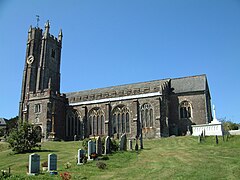Harberton
| Harberton | |
|---|---|
 St Andrew's Church, Harberton | |
| Population | 1,285 |
| OS grid reference | SX777585 |
| Civil parish |
|
| District | |
| Shire county | |
| Region | |
| Country | England |
| Sovereign state | United Kingdom |
| Police | Devon and Cornwall |
| Fire | Devon and Somerset |
| Ambulance | South Western |
Harberton is a village, civil parish and former manor 3 miles south west of Totnes, in the South Hams District of Devon, England. The parish includes the village of Harbertonford situated on the main A381 road. In the 2001 census the parish had a population of 1,285.[1] The village is a major part of the electoral ward of Avon and Harbourne. At the 2011 census the ward population was 2,217.[2]
Etymology
The village takes its name from the River Harbourne, which flows through the parish.
Church of St Andrew
The Parish Church of St Andrew is a fine building of the 14th to 15th centuries with a handsome tower. The late medieval rood screen is a notable example with richly carved cornice and vaulting. The font is a very fine piece of Norman work and the pulpit is 15th century.[3]
Harberton, Tierra del Fuego
Harberton was the home of Mary Ann Varder (1842–1922), who married Thomas Bridges on August 7, 1869 and moved with him in 1871 to Tierra del Fuego. There they established an estancia in 1886, which they named Harberton after Mary's birthplace.[4]
History
Anglo-Saxons
According to Risdon (d.1640), Harberton was the residence of Alric the Saxon.[5]
Normans
Harberton was one of twelve feudal baronies in Devonshire said to have existed according to Pole (d.1635).[6] It was not however recognised as such in the 1960 work by Sanders, English Baronies.[7]
Domesday Book
Harberton is not mentioned in the Domesday Book of 1086, as it was then a constituent estate of the manor of Chillington, which is listed.
Bigod
According to Risdon (d.1640), Roger le Bigod (d. 1107), was seized of lands in Harberton.[8]
de Nonant

- Roger I de Nonant (d.pre-1123). The estate of Harberton was granted out of the royal manor of Chillington (in the parish of Stockenham) by King Henry I (1100-1135) to Roger I de Nonant[10] (d.pre-1123), feudal baron of Totnes[11]
- Guy de Nonant (d. pre-1141)[12]
- Roger II de Nonant (d.circa 1177), a supporter of Empress Maud.[13]
- Henry de Nonant (d.1206).[14]
- Roger III de Nonant, who married a certain Alice, but without consent of King John (1199-1216), who seized his barony of Totnes back into crown lands.[15]
de Vautort

The feudal barony of Harberton was granted to the de Vautort family, feudal barons of Trematon, Cornwall. Surviving sources (i.e. Pole, Risdon and Sanders)[17] confuse between themselves the names Roger, Reginald and Ralph de Vautort, leading to disparate and irreconcilable accounts of the true descent of the family. All accounts however agree that it was held for several generations by this family, which died out in the male line in the 13th century.
Notable residents
Dr John Huxham, the surgeon and doctor, was born here in 1672.
References
- ^ ONS 2001 census
- ^ "Avon and Harbourne ward 2011". Retrieved 19 February 2015.
- ^ Betjeman, John, ed. (1968) Collins Pocket Guide to English Parish Churches; the South. London: Collins; p. 162
- ^ Bridges, E. L. (1948) Uttermost Part of the Earth : Patagonia & Tierra del Fuego. London: Hodder & Stoughton, 1948; republished 2008, Overlook Press ISBN 978-1-58567-956-0
- ^ Risdon, Tristram (d.1640), Survey of Devon, 1811 edition, London, 1811, with 1810 Additions, p.165
- ^ Pole, Sir William (d.1635), Collections Towards a Description of the County of Devon, Sir John-William de la Pole (ed.), London, 1791, Book I, p.21
- ^ Sanders, I.J. English Baronies: A Study of their Origin and Descent 1086-1327, Oxford, 1960
- ^ Risdon, p.165
- ^ Pole, p.445
- ^ Thorn, Caroline & Frank, (eds.) Domesday Book, (Morris, John, gen.ed.) Vol. 9, Devon, Parts 1 & 2, Phillimore Press, Chichester, 1985, part 2 (notes), 1,34
- ^ Sanders, p.89
- ^ Sanders, p.89
- ^ Sanders, p.89
- ^ Sanders, p.89
- ^ Pole, p.11
- ^ per Pole, Sir William (d.1635), Collections Towards a Description of the County of Devon, Sir John-William de la Pole (ed.), London, 1791, p.505
- ^ Pole, p.21; Risdon, p.165; Sanders, p.90
